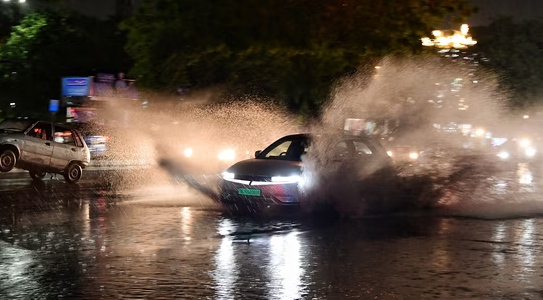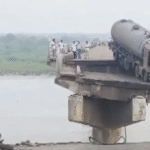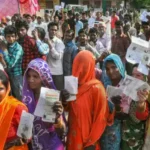July 9 Rainfall Shuts Down Delhi: 141 mm of Rain Floods City, Triggers Major Commute Disruptions
July 9 rainfall shuts down Delhi as 141 mm of rain floods city and triggers major commute disruptions across road, air, and metro travel networks.
Prelude to the Monsoon Chaos in Delhi
On July 9, 2025, Delhi found itself grappling with one of the most disruptive downpours of the monsoon season. A city known for its chronic struggles with seasonal rains—flooded roads, overwhelmed drainage, and snarled traffic—was once again brought to a near standstill. What began as a muggy, overcast afternoon quickly turned into a full-fledged urban monsoon emergency, triggered by the convergence of complex meteorological systems.
Despite uneven rainfall across the National Capital Region (NCR)—with some areas receiving as much as 60mm and others as little as 1.4mm—the consequences were widespread and severe. Public and private mobility systems were thrown into disarray. Key arterial routes were submerged, hundreds of flights faced delays, and the city’s metro system experienced significant slowdowns.
Meteorological Triggers and Forecast Revisions
The India Meteorological Department (IMD) had initially issued a yellow alert for light to moderate rainfall on the morning of July 9. However, as the day progressed, weather patterns began shifting dramatically. By mid-afternoon, dark clouds cloaked much of the city, prompting the IMD to revise its forecast.
By 3:45 PM, the IMD had escalated its alert level to orange, predicting moderately intense rain for northwest and northeast Delhi. This was further upgraded to a red alert by 6:30 PM as intense showers began inundating large swathes of the city. According to IMD classifications, rainfall is considered heavy when it exceeds 64.4mm in a 24-hour period.
Several meteorological conditions contributed to this deluge. Two upper-air cyclonic circulations—one over northern Haryana and another over northwest Uttar Pradesh—interacted with a northward-shifted monsoon trough, creating a concentrated rain-bearing system over Delhi. IMD scientist Naresh Kumar confirmed that the trough was expected to remain in proximity to the NCR through Thursday, before shifting southward and weakening rainfall activity over the weekend.
Data gathered between 5:30 PM and 8:30 PM from various stations revealed uneven but impactful rainfall patterns: Najafgarh (60mm), Ayanagar (50.5mm), Pragati Maidan (37.7mm), Pusa (30.5mm), North Campus (22mm), and Palam (14.4mm), while the Safdarjung base station recorded only 1.4mm.
Disruption in Daily Life and Traffic Paralysis
The ramifications of these sudden showers were felt almost immediately. The downpour began during peak evening hours, unleashing citywide chaos. Several arterial routes—essential lifelines of Delhi’s traffic network—were soon under water. Mathura Road, Outer Ring Road, and the Delhi-Gurgaon highway experienced long traffic jams. Routes like Bishambar Das Marg, Mahipalpur, ITO, Shastri Park, and Krishna Nagar witnessed complete traffic gridlock.
South Delhi was particularly hard-hit. Both carriageways of Mathura Road between Ashram Chowk and Badarpur were choked, while bumper-to-bumper traffic brought movement to a crawl between Munirka and Okhla on the Outer Ring Road. Affected zones extended to central and east Delhi as well—Shyama Prasad Mukherjee Marg, New Rohtak Road, Najafgarh Road, and Vikas Marg saw extended congestion.
The Delhi Traffic Police, in response, ramped up field personnel deployments and coordinated with civic agencies to deploy mobile pumps in flood-affected areas. According to Additional Commissioner of Police (Traffic), Dinesh Kumar Gupta, this was done to “regulate traffic flow and clear roads of waterlogging.”
Public and Governmental Response
In the midst of the urban crisis, Delhi’s Public Works Department (PWD) and Water Minister Parvesh Verma made site inspections to known waterlogging hotspots. Minto Bridge, historically notorious for turning into an urban lake during heavy rains, showed no signs of water accumulation. Verma shared visuals on social media, asserting the government’s efforts to rectify waterlogging issues across the city.
Meanwhile, Delhi’s Indira Gandhi International Airport advised travelers to consider alternative transportation modes such as the metro. Despite normal airport operations, poor road conditions posed significant delays for travelers. Airlines like IndiGo echoed these advisories.
Six flights were confirmed to have been diverted due to poor weather conditions—two to Lucknow and four to Jaipur. Flight tracking portals like Flightradar24 reported delays in over 300 flights, with an average delay duration of 38 minutes.
Broader Context of Monsoon Trends in Delhi
The onset of the monsoon in Delhi on June 29, 2025, was two days behind schedule. However, it was nine days early for the rest of the country. Since the onset, the capital had seen subdued monsoon activity, logging only 19.6mm of rainfall for July until July 9—against a monthly average of 209.7mm. By comparison, July 2024 had recorded 203.7mm of rainfall.
Wednesday’s rainstorm thus represented a significant proportion of the total rainfall so far this season. Meteorologists believe this event was in line with predictions by international models such as the Global Forecast System (GFS), which had indicated over 50mm rainfall within the 24-hour window between July 9 and July 10.
Air Quality and Temperature Trends
Despite the chaos caused by rain, one silver lining was the improvement in Delhi’s air quality. The Air Quality Index (AQI) was recorded at 81 (satisfactory) on July 9, improving further from Tuesday’s figure of 98. This marked the 14th consecutive day of satisfactory air quality in the capital—an unusual and welcome development in a city often ranked among the most polluted globally.
Temperatures also saw a dip. On July 9, the maximum temperature stood at 35.6°C—one degree below normal. The minimum dropped to 26.4°C, two degrees below the average for this time of year. The IMD forecast for July 10 expected further cooling, with maximum temperatures between 31°C and 33°C and minimums ranging from 22°C to 24°C.
Economic Implications and Business Disruptions
The sudden deluge on July 9 did not spare the business sector either. Delhi’s bustling commercial districts—Connaught Place, Nehru Place, and Lajpat Nagar—witnessed drastically reduced footfalls. With arterial roads flooded and public transport disrupted, many businesses reported closures or low productivity.
Retailers struggled with delayed deliveries, while food delivery platforms suspended services in affected zones due to safety concerns. Office-goers from tech parks in Gurugram and Noida faced extended commutes or were forced to return home.
Financial institutions reported staff shortages as employees were unable to reach offices, while BPOs and call centers invoked work-from-home protocols. While the Reserve Bank of India kept markets open, volumes on the Delhi stock terminals dropped nearly 30% below daily averages.
Educational Institutions and Commuter Impact
Schools and colleges across Delhi-NCR were caught off guard by the timing of the storm. Several institutions had conducted classes until afternoon before the rains struck. School buses were stranded on waterlogged roads, causing concern among parents.
Many private schools announced last-minute online classes or half-day closures on July 10 to avoid repeat disruptions. Delhi University postponed internal assessment tests in select colleges, while coaching institutes in Karol Bagh, Laxmi Nagar, and Mukherjee Nagar canceled evening batches.
The student commuter population was especially affected. Metro station exits at Rajiv Chowk, Kashmere Gate, and Hauz Khas were overcrowded as last-mile connectivity broke down.
Healthcare Sector Readiness
Hospitals across the capital activated emergency protocols in anticipation of weather-related cases. Emergency rooms in AIIMS, Safdarjung, and LNJP Hospitals reported a rise in accidents and slip injuries.
Ambulances experienced longer response times due to flooded routes. Non-critical appointments and surgeries were postponed in some private hospitals. Teleconsultation services saw a temporary surge as patients preferred remote healthcare.
Healthcare authorities also issued advisories regarding waterborne illnesses, cautioning citizens against consuming contaminated rainwater, especially in flood-affected colonies.
Civic Planning and Urban Drainage Challenges
Experts and urban planners criticized the city’s outdated drainage and runoff systems. The Delhi Jal Board and MCD faced backlash for not completing desilting work before monsoon onset. Despite claims of 80% readiness, several low-lying areas were inundated within minutes.
Urban development experts stressed the need for comprehensive stormwater management policies. They recommended smart sensors, pervious pavements, and updated drainage maps as critical measures for climate-resilient infrastructure.
With Delhi’s urban sprawl expanding rapidly, the consequences of poor planning and haphazard construction have come under renewed scrutiny.
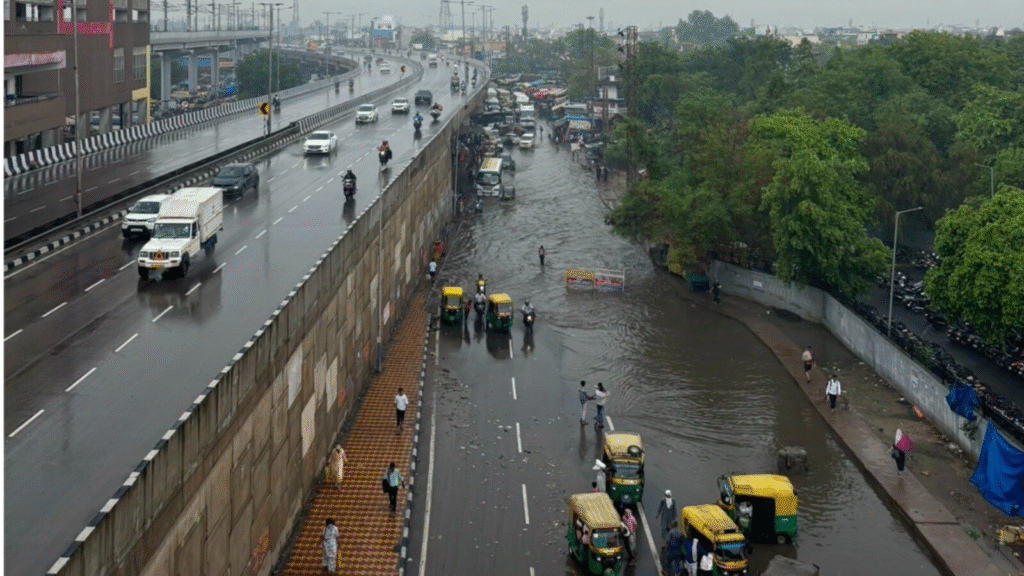
Impact on Informal Sector and Daily Wage Earners
The heaviest burden of the rain-induced disruption was borne by the city’s informal workforce. Daily wage earners, construction laborers, and domestic workers were unable to report to work, leading to income losses that may span days.
Vendors in informal markets such as Sarojini Nagar, Kamla Nagar, and weekly haats faced damage to perishable inventory and lower footfalls. Those dependent on daily earnings found themselves without recourse or state protection.
Social scientists emphasized that urban weather shocks increasingly hurt the city’s most vulnerable populations, urging inclusive policy frameworks for climate resilience.
Effect on Urban Poor and Slum Dwellers
In colonies like Seelampur, Sangam Vihar, and Bhalswa, residents faced severe flooding inside homes. Open drains overflowed into residential lanes, raising risks of disease outbreaks.
With limited access to drainage or civic services, slum dwellers relied on makeshift defenses like sandbags and plastic sheets. The Delhi Urban Shelter Improvement Board was criticized for failing to preemptively identify flood-prone communities and provide shelter.
Non-governmental organizations launched emergency response units for food, water, and sanitation supplies.
Role of Smart City Technologies
Delhi’s Smart City project came under the spotlight. Critics noted that despite heavy investment in surveillance and digital infrastructure, waterlogging detection systems and flood-response tools were either missing or malfunctioning.
Officials responded that sensor-based drain monitoring had been piloted in limited zones like Karol Bagh but not scaled up. Calls grew louder for real-time water level tracking and predictive analytics using AI.
The civic agencies acknowledged gaps in technology integration and promised comprehensive post-monsoon reviews.
Response by Emergency Services
The National Disaster Response Force (NDRF) deployed rapid action teams in southeast and southwest districts by evening. State disaster units evacuated stranded passengers near Minto Bridge and Hauz Khas.
Fire department officials responded to dozens of distress calls, including fallen trees, short circuits, and collapsed hoardings. Rain-related fire incidents spiked, particularly in older areas with overhead wiring.
Rescue units worked through the night as reports of missing persons and collapsed walls were received.
Power and Communication Outages
Localized power outages were reported in South Extension, Mehrauli, and Shahdara. Delhi Transco Ltd. stated that supply disruption was triggered by snapped overhead lines and substation inundation.
Telecom networks experienced latency due to wet optical fiber cables and damaged junction boxes. Residents reported difficulties accessing mobile data and making calls, especially in low-lying zones.
Utility companies raced to restore services, prioritizing hospitals and water pumping stations.
Power and Communication Outages
Localized power outages were reported in South Extension, Mehrauli, and Shahdara. Delhi Transco Ltd. stated that supply disruption was triggered by snapped overhead lines and substation inundation.
Telecom networks experienced latency due to wet optical fiber cables and damaged junction boxes. Residents reported difficulties accessing mobile data and making calls, especially in low-lying zones.
Utility companies raced to restore services, prioritizing hospitals and water pumping stations.
Political Reactions and Administrative Accountability
The downpour reignited political tensions in Delhi. The opposition Bharatiya Janata Party (BJP) accused the Aam Aadmi Party (AAP) government of mismanagement and negligence. BJP leader Adesh Gupta stated, “Year after year, Delhi is submerged because of hollow promises. The administration is simply unprepared.”
In response, Delhi’s Environment Minister Gopal Rai countered, blaming legacy infrastructure and central agencies for the systemic failures. “This is a shared responsibility. Until all agencies, including MCD and DDA, collaborate seamlessly, there can be no permanent solution,” he stated.
The Delhi Legislative Assembly has scheduled a special session to discuss monsoon preparedness and civic failures.
Environmental Consequences and River Levels
Heavy rainfall also led to a rise in the Yamuna River’s water levels. By midnight on July 9, the Central Water Commission recorded a level of 203.15 meters—just 1.35 meters below the warning mark.
Concerns were raised about low-lying areas like Yamuna Bazar, Rajghat, and Bela Estate being inundated if rainfall continued.
Environmentalists warned that years of encroachment and concretization along the river’s floodplain had made the city more vulnerable to flash floods and urged for urgent ecological restoration measures.
Transportation Network Overhaul Plans
Transport experts highlighted the need for structural overhauls in urban mobility planning. Suggestions included elevating key road corridors, deploying smart flood sensors at metro and bus depots, and investing in more amphibious urban vehicles.
The Delhi Metro Rail Corporation (DMRC) announced plans to audit drainage at all stations following reports of water seepage.
Indira Gandhi International Airport officials also called for a review of runway and taxiway drainage to reduce future flight delays.
Role of Media and Social Platforms
Mainstream media provided wall-to-wall coverage of the crisis. Channels like NDTV, India Today, and Doordarshan ran hourly bulletins highlighting commuter struggles and civic failure.
Social media played a dual role. While users flooded platforms with videos of submerged streets and stranded vehicles, misinformation also spread rapidly.
Delhi Police issued advisories warning against sharing unverified claims and images. Twitter/X, Instagram, and WhatsApp became primary crisis communication tools for citizens and agencies.
Civil Society Response and Volunteer Efforts
Citizens groups and NGOs quickly mobilized to provide relief. Initiatives like Delhi Flood Relief and Roti Bank distributed food and drinking water in Najafgarh, Trilokpuri, and Okhla.
Resident Welfare Associations (RWAs) coordinated with municipal bodies to pump out water from basements and underpasses.
Delhi’s volunteer community emphasized the importance of decentralizing disaster response and enabling local bodies with quicker funding and resource allocation mechanisms.
Insurance Claims and Legal Redress
As the floodwaters receded, insurers saw a sharp rise in claims related to vehicle damage, home inundation, and disrupted business operations. Companies such as LIC, HDFC Ergo, and ICICI Lombard reported a 40% increase in damage-related calls.
Lawyers noted a growing interest in filing PILs (Public Interest Litigations) against municipal bodies for negligence. Consumer forums also began seeing complaints from residents in flood-affected colonies who claimed that pre-monsoon drain desilting was not carried out despite official assurances.
Legal experts emphasized the need for clearer liability mechanisms between civic bodies and private service providers.
Cultural Heritage Sites and Preservation Concerns
Historic sites such as Humayun’s Tomb, Qutub Minar, and Red Fort faced minor flooding in their peripheries. The Archaeological Survey of India (ASI) deployed emergency teams to prevent water damage.
Waterlogged access roads discouraged tourists, leading to reduced visitor numbers. Conservationists warned that unchecked water stagnation could cause seepage and mold growth on ancient stonework.
There were renewed calls to install better drainage systems at heritage sites to protect their structural integrity during extreme weather events.

Corporate Sector Resilience and CSR Initiatives
Large corporations based in Delhi-NCR activated continuity plans. Infosys, HCL, and TCS transitioned thousands of employees to remote work. Meanwhile, CSR arms of companies such as Tata Trusts and Reliance Foundation initiated aid drives.
CSR funds were redirected to supply water pumps, tarpaulin, and sanitary kits in low-income neighborhoods. These private sector responses highlighted the growing role of corporations in urban climate resilience.
Experts stressed that future CSR frameworks must account for disaster readiness and support climate-adaptive infrastructure.
Psychological and Mental Health Impact
The flooding episode triggered widespread stress and anxiety, especially among vulnerable populations. Psychologists reported spikes in patients complaining of panic, sleep disturbances, and helplessness.
Mental health helplines like iCall, Fortis MIND, and Vandrevala Foundation received double the usual call volumes on July 9 and 10.
Doctors emphasized the mental toll of repeated urban flooding, urging government health departments to integrate psychological support in disaster response protocols.
Youth Engagement and Student-Led Climate Activism
Youth-led groups such as Fridays for Future India and Extinction Rebellion Delhi mobilized digital campaigns under hashtags like #DrainDelhi and #MonsoonJustice. They called out what they termed “chronic apathy” in urban climate planning.
Student volunteers from Delhi University and JNU helped deliver relief kits to slum communities. Many also gathered testimonials and photographic evidence to petition for improved civic monitoring.
Youth engagement was hailed as critical in creating long-term political pressure for sustainable city planning.
Urban Ecology and Wetland Restoration
Environmentalists renewed calls to restore Delhi’s natural wetlands, which historically acted as flood buffers. Areas like Sanjay Van, Najafgarh Jheel, and Yamuna floodplains have been increasingly encroached upon, reducing their capacity to absorb excess rainwater.
Ecological experts proposed mapping urban catchments and reintroducing traditional water harvesting models. Several demanded protection of Aravalli foothills as a rainwater recharge zone.
The Delhi High Court had earlier issued directions to halt encroachments on eco-sensitive zones, but enforcement remains patchy.
Lessons from Global Cities
Comparative analysis with cities like Tokyo, Amsterdam, and Singapore was discussed in policy circles. These global cities have invested in underground reservoirs, green roofs, and smart drainage grids.
Experts suggested a hybrid model for Delhi—combining traditional Indian water wisdom with modern infrastructure. Municipal authorities have been urged to study climate-resilient urban plans of coastal cities facing similar monsoon risks.
Scientific Research and Climate Models
The Indian Institute of Tropical Meteorology (IITM) and Delhi-based think tanks began analyzing rainfall data from July 9 to understand anomalies and patterns.
Preliminary results indicated that localized cloudbursts and rising surface temperatures had amplified the intensity of rains. IITM researchers also warned of more frequent high-intensity rainfall episodes due to accelerating climate change.
They proposed setting up a city-specific monsoon model with real-time inputs to forecast extreme events more accurately.
Long-Term Policy Recommendations
Urban planners advocated for an integrated flood management policy for Delhi, led by a unified command instead of fragmented municipal jurisdictions.
Recommendations included creating an Urban Monsoon Authority, installing rainwater gauges in every ward, incentivizing rainwater harvesting, and holding RWAs accountable for illegal drain blockages.
Experts called for mandatory climate resilience audits for all infrastructure projects, particularly under Smart City and Amrut schemes.
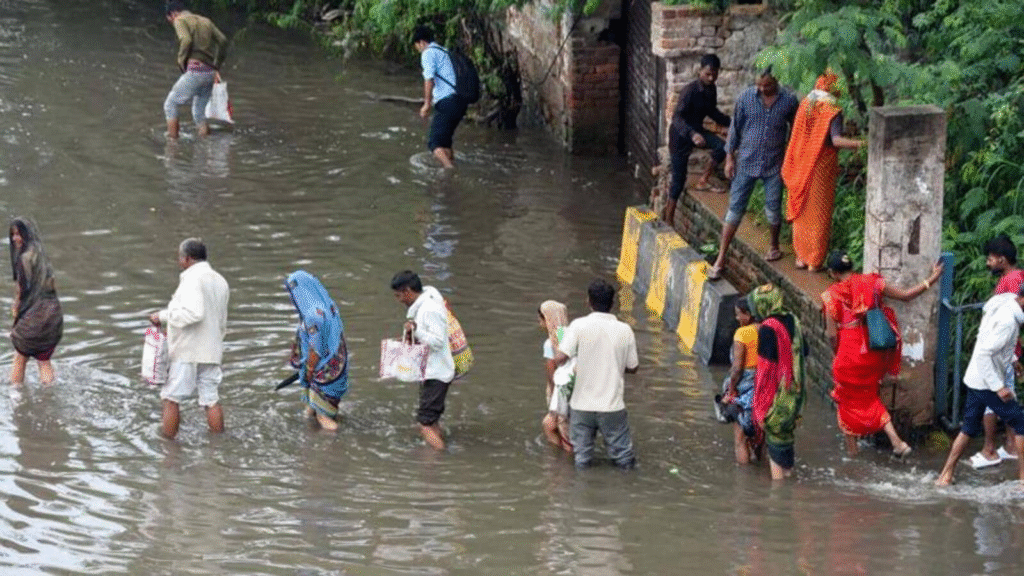
The Road Ahead
Delhi’s July 9 flood will be remembered as both a natural disaster and a man-made urban planning failure. The episode underlined the capital’s fragility in the face of climate volatility and administrative inertia.
The flood revealed systemic cracks—from poor drainage to inadequate policy implementation. But it also showcased citizen spirit, youth engagement, and institutional potential for reform.
The hope remains that Delhi will emerge not only more prepared for the next downpour but also more determined to rewrite its urban destiny in a climate-challenged world.
Also Read : ECI Issues 1 Official Clarification on RJD MP Manoj Jha’s Electoral Roll Post Shared by 5M+ Users


